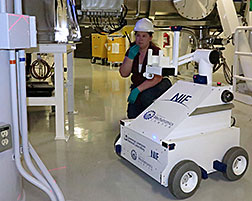- Number 395 |
- August 19, 2013
Robot joins ranks of the National Ignition Facility

System Manager Casey Schulz successfully
running D2T3 through his paces, negotiating
obstacles in the NIF Target Bay.
A new employee will soon be added to the roster of those working on Level 2 of the National Ignition Facility's (NIF) Target Bay. His name is D2T3, and his duties will be a bit different than those of his colleagues at DOE's Lawrence Livermore National Laboratory.
D2T3 — named for the hydrogen isotopes that serve as fuel for NIF's fusion targets — is a radiation-detecting, remote controlled robot. Currently in testing and training mode, he will be fully deployed in September after three years of development.
D2T3 has found his place in the NIF duty roster due to the continuing success of the facility's experiments. As NIF laser shots continue to yield higher and higher neutron yields — a marker of the facility's ultimate goal, fusion ignition — the immediate environment of the Target Bay is inhospitable to humans. Currently, the area remains sealed for a number of hours based on radiation decay models before radiation technicians enter to verify that levels are safe. As a safety precaution, this wait is longer than models predict to provide a safety buffer.
However, D2T3 doesn't have the same constraints as his human colleagues. He can patrol the Target Bay immediately after a shot and measure the remaining radiation levels, providing an accurate and timely notification for when it is safe to re-enter. He also can provide real-time decay information, allowing for fine-tuning of the current models.
"This is the first actual, non-tethered robot we've got," said Casey Schulz, a mechanical and robotics engineer who serves as the system manager for D2T3. "It expands the capability of NIF, improves efficiency and maintains the high level of safety we require. It's logically the next step as we continue to reach higher and higher neutron yields."
D2T3 was developed in partnership with the California Mechatronics Center at California State University, Chico.[Breanna Bishop, 925.423.9802,
bishop33@llnl.gov]
